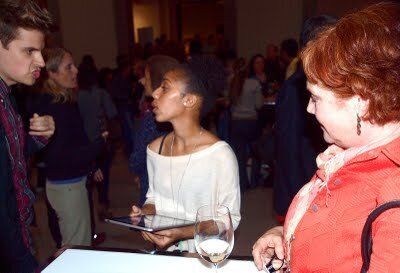
Last month when the Ontario Science Centre (OSC) held a media launch for an exhibition of miniature
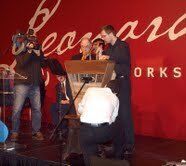
working models of some of Leonardo da Vinci's greatest inventions, Massimiliano Lisa, curator of the traveling show, dedicated the day to the memory of Steven Job. Lisa (no relation to Mona) compared the game changing genius of Da Vinci to the intellect of the recently deceased head of Apple.
The room full of science geeks agreed with the visiting curator. Little did they know how much Jobs has changed how PR people like me stage media events -- including the event they were at.
In the old days -- a year ago -- there was a certain never-stray-from blue print for the physical set-up of a press event. The appearance at pressers of the iPad, the iPhone, and vastly improved lightweight cameras, video recorders, and audio recorders has forced publicists in the non-profit Arts sector to change how media events are set up and run.
Back in 2010, there is a raised well-lit stage, a podium (large enough to hold radio tape machines -- and at an angle not too acute so they won't slide off), seating for 20, a raised platform for video cameras, a sound board where cameras and audio recorders can plug in, and a check-in table where the media can leave their contact numbers and pick up press kits, DVD photo/avi files, and small capacity memory sticks loaded with releases and photos. The audio speakers are hidden from view and there are power bars on the floor for the cameras and their lights.
Now in 2011, as many bloggers and social media journalists are showing up at pressers with Jobs-generation equipment as are traditional media journalists. And while regular media people tend to travel in packs with bulky power-hungry video cameras, a whack of large format cameras, laptops (for post-event editing), and bulky sound recording devices, the needs for the social media are completely different. Publicists need publicity, and social media delivers just that. Social media journalists attending events are as important as regular media so changes to the set up of the room have had to be made.
WHERE ARE THE AUDIO SPEAKERS?
At the McMichael Canadian Art Collection, (where I help out) a decision was made several years ago to have the public address speakers in the Great Hall hidden in the ceiling, 10 metres above the stage. The reasoning back then was that media would not record off the speakers but instead would plug into a soundboard to get a direct distortion-free feed from the podium microphones. Audio speakers were seen as a visual distraction.
I-PHONE IS A PORTABLE AUDIO RECORDER FOR MANY REPORTERS
This was a "sound" philosophy back then, but, nowadays it doesn't work that way. Many attendees at
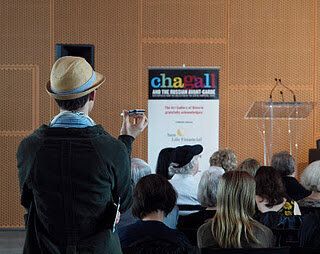
press conferences now use iPhones and other smartphone units to record the spoken word. Trouble is, there isn't a universal plug-in size for smart phones and digital recorders to record off those old technology AV sounds boards. Most iPhone journalists now stand as close as they can to event loud speakers and hold their phones like pizzas to record the sound until their arm gives out!
I saw this last month at the Art Gallery of Ontario (AGO) opening of a Marc Chagall painting exhibition. A social media reporter (see photo) wanted audio of the European curators talking about the Marc Chagall exhibition so he stood near the speaker columns and held up his iPhone to get the bits that he needed for his online radio show!
PLATFORM FOR CAMERAS NOT AS CROWDED AS IT USED TO BE
The traditional press conference platform for cameras on tripods was important to give unobstructed TV newsroom footage of the speeches. The raised platform gives a clear shot at the stage. Trouble is in 2011, with people using lightweight cameras, the static camera shot is no longer important.
At the Sun, traditional photographers are going the way of the reel-to-reel recorder. Reporters are expected to shoot stills, video, and take notes at pressers. Nowadays reporters, social media practitioners, and camera people are everywhere doing everything. Sitting on the floor in front. Standing in the wings. Getting shots from behind the stage. Sometimes they aren't even in the room depending instead upon Skype and online coverage of the conference (provided by the host of the presser).
SOCIAL MEDIA JOURNALISTS DON'T KNOW THEIR PLACE
Cameraman from mainstream media have to compete with new reporters who have no sense of the old press conference decorum (stay in your seat till the speeches are over) and are prone to wandering onto the stage with their cameras in hand. Take a look at the posted photo from the Da Vinci press conference where a CBC TV crew followed a social media camera person and came right up on stage, uninvited, to get a close-up of a musician playing (for the very first time) the Leonardo invention of the Harpsichord-Viola.
And, with more and more reporters using iPads to shoot video, there is no need for a tripod. Their shot sequences, because of arm fatigue, tend to be very short. And the best iPad video shots are as close as possible to the action. Compare the footprint of an iPad reporter and a TV crew at the same AGO presser (for the Marc Chagall exhibition) as pictured below.
NOT JUST VIDEO CAMERAS ANYMORE

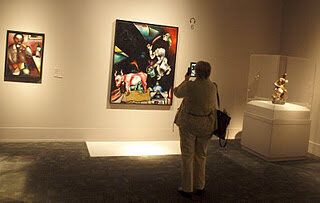
This summer at the Scotiabank Caribbean Carnival Toronto parade there were three media outlets using iPads on the parade route compared to none last year! As well, media at the Scotiabank Toronto Caribbean Carnival (formally known as Caribana), gave up on bulky and expensive digital video cameras and used cheaper Cannon still cameras to shoot high def video as well as traditional photographs.
PRESS KITS GOING, GOING, GONE
Press kits are really just a collection of factoid documents and pictures that tell journalists what they just saw at a media event. They are meant to be used when the reporter returns to the newsroom to write a story. In 2011, some reporters come to events and tweet and blog while the conference is unfolding.
By the time they get their press kit -- be it in print or on a loaded memory stick -- their story has already been filed. That press kit is passé before it has even been opened. To make sure media is better informed publicists are now more willing to embargo information so that journalists and their editors are better informed for their instant reportage. (Of course, that means media can decide not to attend press events if the information isn't newsworthy or interesting enough).
And, with social media's demand for live theatre, pressers are becoming more male/female show-and-tell events rather than the male dominating talking head pressers of 2010 and before.
REDUCE THE NUMBER OF CHAIRS AND BRING IN THE BAR TABLES
To accommodate this new style of instant journalism, press events now are providing several tables (round bar tables are the favoured flavour of the month) to allow social media to work on their iPads and iBooks as the presser unfolds. Good-bye chairs and coffee tables. Lighting takes into account that social media can be covering an event from a variety of spots in the room.
MAKE ROOM FOR THE HELMET CAM AND OTHER SOCIAL MEDIA TOOLS
My son Andrew and I took in the Toronto premier of "My Week With Marilyn" last week at the Varsity

Theatre. Big event. Too many invites sent out, so many people with tickets were turned away. We were two of the lucky ones -- and paid for our luck by sitting in the neck craning front row. Our tickets were thanks to the Marilyn Monroe curator of the McMichael Canadian Art Collection, Chris Finn. He had assisted with the promotion of the movie by Alliance Films. Always interesting to watch other PR people work their events. At the end of the film, the evening's publicist set up director Simon Curtis outside the theatre for a quick interview with a social media reporter. Have no idea who the fellow was, but he didn't seem to feel silly (nor did Simon Curtis) conducting the interview with his camera/iPod mounted on his bike helmet! Photo by Andrew Weir.
NEWSTIME IS BOOZETIME
In the Stephen Jobs world, when you hold a presser depends on whom you expect to come. Traditional media like to have news conferences in the late morning or early afternoon Monday to Friday. Rush hour is over and there is time to get the facts and return to the newsroom to file the story before quitting time. No liquor or food is served, but coffee is appreciated.
Now if you are playing to social media, you gotta realize that a lot of these people work during the day at real jobs and can't cover an 11 a.m. presser. 6 p.m. is not a bad thing if you are pushing a message to You Tube, Twitter, and Facebook audiences. Saturday and Sundays works too.
The Social Media makes for strange bedfellows. It is not unusual to have a blogger show up at event reporting on-line for foreign websites. There are active journalists reporting in Toronto daily, via their iPads to sites in the U.S., Russia, Iran, India, Pakistan, China, and the Philippines.
BTW: Bloggers like me are self-taught, self-employed, and tend to not bother with the ethical and legal worries about accepting free food and liquor. With Twitter people news time is booze time (and bring on that free food).
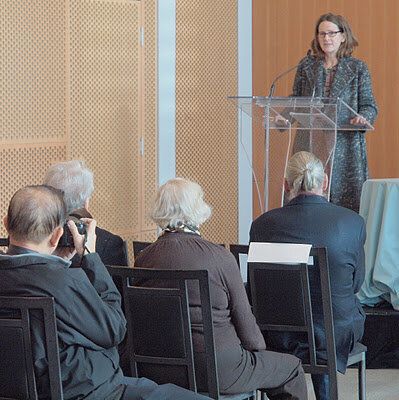
JOBS HAS CHANGED EVERYTHING!
This rush to accommodate iPads and iPhones is not limited to reporters. People holding these media events are using them too...
